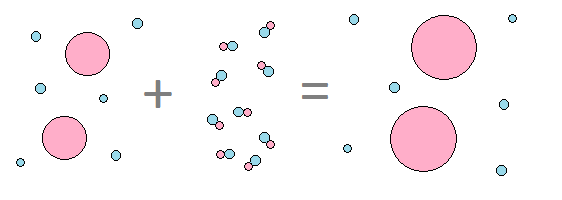The Meganeura, which existed on Earth some 300 million years ago, was a dragonfly the size of a seagull. Its shape indicates that it was able to hunt for food in much the same way that dragonflies do this today. It must have been able to jump about in the air, turn on a dime and perform loops and similar displays of aeronautics.
 |
| Meganeura, lifesize model (from Land of the dead blog) |
The Quetzalcoatlus, which existed on Earth some 60 million years ago, was a flying dinosaur the size of a giraffe. Its shape indicates that it must have been able to hunt for food much the same way that pelicans do so today.
These are conclusions we can draw from Darwin's law which states that no animal will develop a shape that doesn't fit with its habits. If something looks like a dragonfly, it will act like a dragonfly. If something looks like a pelican, it will act like a pelican.
The first things that strike us when it comes to these animals is the size of them and the fragility of their wings. The Meganeura was able to fly like a dragonfly despite being the size of a seagull. That's remarkable, because a seagull is unable to perform dragonfly aeronautics despite having wings that are substantially stronger than what the Meganeura was equipped with.
As for the Quetzalcoatlus, no animal that size is able to fly, certainly not with bat-like wings. The biggest bat currently in existence weighs less than 1.5 kg, yet the Quetzalcoatlus was able to fly despite being the size of a giraffe.
The mismatch between the size of these animals and their ability to fly indicate that something dramatic must have happened. Gravity must have been lower. However, the mystery doesn't stop at gravity. Inertia must have been different too. This becomes clear once we consider the type of manoeuvring that these animals must have been able to perform.
Getting off the ground is but one problem that they had to overcome. It can be explained by suggesting that gravity was less strong. But once the Meganeura was off the ground its thin wings would nevertheless have been a problem. If it tried to turn on a dime, or suddenly jump one way or the other, its wings would break due to the stress of the change in momentum. The animal must have had a body with less inertia than what an identical body would have today.
The same can be said about the Quetzalcoatlus. If its head had the sort of inertia that such a head would have today, its neck would snap the moment it tried to do a pelican like flip of its beak.
This suggests that matter has become heavier in terms of both gravity and inertia since the time when these animals existed. We can use the Meganeura and Quetzalcoatlus as evidence for an increase in gravity and inertia, and a ready explanation for this was suggested by Halton Arp in his time. He believed that matter starts off relatively light and becomes heavier over time. The mechanism alluded to by him, and made explicit in my book is what he called mass condensation:
Protons have become larger over time through the absorption of high energy photons. This has affected both gravity and inertia. Hence, the abstraction that we call mass has increased.
 |
| Protons increasing in size due to mass condensation |
When discussing the fossil records, we tend to get stuck talking about size and gravity. We also tend to focus on the gravity of our planet. However, gravity has two parts to it. One is the planet, and the other is the objects attracted by the planet. If the material of both have increased in mass over time, it's easier to see how the increase could have been as dramatic as it appears to have been.
Based on Newton's universal law of gravity, a doubling in size of the proton will quadruple the gravitational attraction while only doubling inertia. There is probably more going on when it comes to gravity, but mass condensation goes a long way in explaining both the super-sized insects that existed on Earth some 300 million years ago and the enormous size of the dinosaurs that appeared some 200 million years later.

No comments:
Post a Comment